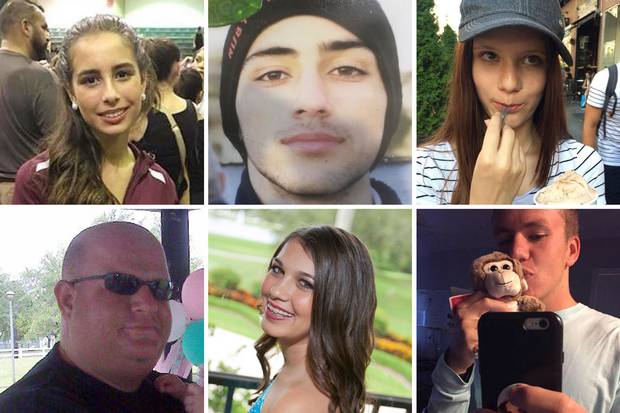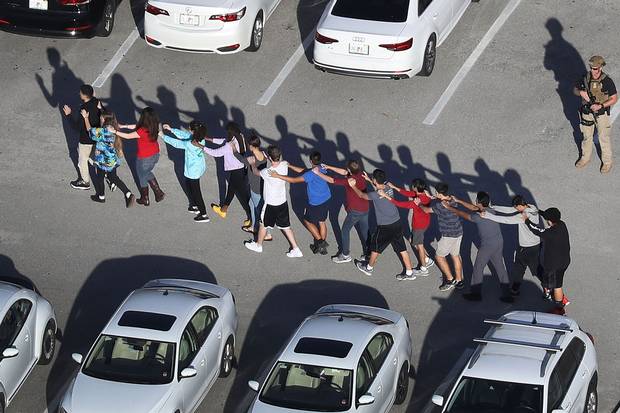The basics
- Seventeen people were killed at a Florida school on Wednesday afternoon in one of America’s deadliest school shootings.
- Police arrested 19-year-old Nikolas Cruz, who had been expelled from Marjory Stoneman Douglas High School in Parkland, Fla., a year before the attack. He was charged Thursday with 17 counts of premeditated murder.
- Authorities have not said what they believe his motive was, but a police arrest report said that the gunman confessed to “shooting students that he saw in the hallways and on school grounds.”
- The scene in Parkland was reminiscent of 2012’s assault at Sandy Hook Elementary School in Newtown, Conn., which killed 26 people, mostly children. The gunman, who also fatally shot his mother in her bed, then killed himself.
- U.S. President Donald Trump addressed the nation in a Thursday speech where he described the attack as a “scene of terrible violence, hatred and evil.” He was silent on the issue of gun control, but said his administration was committed to making schools safer. On Friday, Mr. Trump said he will travel to Florida “to meet with some of the bravest people on earth.” He’s expected to thank first responders and also come face-to-face with parents, survivors and others, some of whom have angrily called for firm action to prevent future assaults.
- Gun-control advocates in Congress were quick to speak out, saying Thursday that they would not shy away from calling out gun violence as the systemic cause of the massacre. In particular, Florida’s enthusiasm for guns (the state has more concealed-weapon permits than any other) is coming under intense scrutiny, The Globe’s Joanna Slater explains.
Where and how it happened
Wednesday's shooting took place at Marjory Stoneman Douglas High School in Parkland, Fla., near Fort Lauderdale, just before dismissal at about 2:40 p.m. Just before the shooting broke out, an alarm went off; some students thought they were having another fire drill, an exercise had forced them to leave their classrooms hours earlier, so they once again filed out into the hallways.
Authorities say the man who pulled the fire alarm was the alleged gunman, 19-year-old Nikolas Cruz. Equipped with a gas mask, smoke grenades and multiple magazines of ammunition, the gunman opened fire with a semi-automatic weapon, sending hundreds of students fleeing into the streets. Hearing loud bangs as the shooter fired, many students inside hid under desks or in closets, and barricaded doors.
According to the sheriff's office report, Mr. Cruz discarded his weapon, a vest and ammunition in a stairwell, blended in with fleeing students and got away. After leaving the school, Mr. Cruz walked to a Walmart, bought a drink at a Subway and stopped at a McDonald's. A police officer confronted him about 40 minutes after he left the McDonald's, the county sheriff said. He was taken into custody without a fight. After the arrest he was treated in hospital for laboured breathing, and questioned overnight before being booked into jail.

Some of the 17 victims of the Parkland high-school shooting. Clockwise from top left: Gina Montalto, Joaquin (Guac) Oliver, Alaina Petty, Nicholas Dworet, Jaime Guttenberg, Aaron Feis.
FACEBOOK, FAMILY HANDOUTS/ASSOCIATED PRESS
The victims
Seventeen people were killed in the attack, authorities said. Twelve were found dead inside the school, while others were killed outside or died in hospital afterward.
The dead included high-school athletes and faculty members, including popular football coach Aaron Feis and geography teacher Scott Beigel, who reportedly died trying to protect students from the gunman. They ranged in age from 14 to 49. Here are some fuller profiles of the victims.
The suspect
Students, neighbours and law-enforcement officials describe the suspect as a troubled teenager who threatened and harassed his peers, talked about killing animals and posed with guns in disturbing photos on social media. Here are the basics.
Explulsion: Mr. Israel, the county sheriff, said Mr. Cruz had been expelled from Marjory Stoneman Douglas for "disciplinary reasons." However, Victoria Olvera, a 17-year-old junior, said Mr. Cruz was expelled last school year after a fight with his ex-girlfriend's new boyfriend. She said Mr. Cruz had been abusive to his girlfriend.
White nationalist ties: Jordan Jereb, leader of the white nationalist militia Republic of Florida, told Associated Press Mr. Cruz was a member of his group and participated in paramilitary drills in Tallahassee. Investigators said they have not confirmed any such ties and were looking into it.
Family life: Mr. Cruz was an orphan: His mother, Lynda Cruz, died of pneumonia on Nov. 1, neighbours, friends and family members said, according to the Sun Sentinel, and her husband died of a heart attack several years ago. The couple adopted Nikolas and his biological brother, Zachary, after the couple moved from Long Island in New York to Broward County. The boys were left in the care of a family friend after their mother died, said family member Barbara Kumbatovich of Long Island. Unhappy there, Mr. Cruz asked to move in with a friend's family in northwest Broward. The family agreed and Mr. Cruz moved in.
Social media: Daniel Huerfano, a student who fled Wednesday's attack, said he recognized Mr. Cruz from an Instagram photo in which Mr. Cruz posed with a gun in front of his face. Dakota Mutchler, a 17-year-old junior who said he used to be close friends with Mr. Cruz but hadn't seen him in more than a year, recalled Mr. Cruz posting on Instagram about killing animals and said he had talked about doing target practice in his backyard with a pellet gun. "He started going after one of my friends, threatening her, and I cut him off from there," Mr. Mutchler said.
The weapon
Law-enforcement officials said the gunman was found with an AR-15, a semi-automatic rifle based on the U.S. military's M-16. Mr. Cruz legally purchased the weapon about a year ago, a law enforcement official familiar with the investigation but not authorized to discuss it publicly told Associated Press on condition of anonymity.
The National Rifle Association describes the AR-15 as the "most popular rifle in America." It has been involved in some of America's deadliest mass shootings over the past few years, including:
- Sandy Hook Elementary School shooting, Newtown, Conn. (Dec. 14, 2012)
- Pulse nighclub shooting, Orlando, Fla. (June 12, 2016)
- Las Vegas concert shooting (Oct. 1, 2017)
- Sutherland Springs church shooting, Texas (Nov. 5, 2017)
U.S. gun-control advocates spoke quickly after the shooting to press for change and call out U.S. gun culture as the massacre's cause. In Washington, Florida Senator Bill Nelson told a silent chamber that tightening restrictions on assault weapons is imperative:
To those who say now is not the time to talk about gun violence because it's too soon ... When is the time? How many more times do we have to do this? How many more folks have to die? Let's do what needs to be done and let's get these assault weapons off our streets.
Feb. 15, 2018: Students gather during a vigil at Pine Trails Park in Parkland, Fla., for the victims of the shooting.
Brynn Anderson/Associated Press
America in mourning
Wednesday's shooting was a familiar horror to Americans, who have seen three of the country's 10 deadliest mass shootings in the past five months. Here's a roundup from The Globe's Joanna Slater of how Americans expressed their grief and anger on social media.
I cannot bear to see one more photo of innocent kids walking out of school with their arms over their heads. This has to stop. The NRA supports domestic terrorism. #GunControlNow
— rosanne cash (@rosannecash) February 14, 2018
Political reaction
White House: U.S. President Donald Trump offered his condolences to the victims' families and said there were "so many signs the Florida shooter had been mentally disturbed." Mr. Trump has cited mental health before as a cause for mass shootings, dismissing questions about gun control. Attorney General-Jeff Sessions also focused on mental health, saying he wants the Justice Department to study how mental illness and gun violence intersect.
Trump calls for healing after Florida school shooting
Florida: Republican Governor Rick Scott has joined law enforcement agents near the site of the shooting and offered his condolences to the victims' families and survivors. He says the attack "is just absolutely pure evil."
Just spoke with @POTUS about shooting at Marjory Stoneman Douglas High School. My thoughts and prayers are with the students, their families and the entire community. We will continue to receive briefings from law enforcement and issue updates.
— Rick Scott (@FLGovScott) February 14, 2018
Democrats: In both houses of Congress, Democrats spoke out about the need for gun control, with House Minority Leader Nancy Pelosi saying Congress had a "moral responsibility" to "prevent the daily tragedy of gun violence." Former president Barack Obama shared his condolences on Twitter and called for "long overdue, common-sense gun laws."
We are grieving with Parkland. But we are not powerless. Caring for our kids is our first job. And until we can honestly say that we're doing enough to keep them safe from harm, including long overdue, common-sense gun safety laws that most Americans want, then we have to change.
— Barack Obama (@BarackObama) February 15, 2018
Canada: Prime Minister Justin Trudeau called Mr. Trump to offer his condolences after the shooting, telling him "Canadians stand in solidarity with the people of the United States at this difficult time," the Prime Minister's Office said in a statement.
On a call with @POTUS Trump tonight, I expressed Canada’s condolences and our best wishes for a full recovery to all those injured in yesterday’s shooting in Parkland, Florida: https://t.co/VAWfb5Mh43
— Justin Trudeau (@JustinTrudeau) February 16, 2018
Vatican: Pope Francis sent a telegram Thursday to the archbishop of Miami saying he was "deeply saddened" to learn of the "devastating attack," the Vatican said.
With reports from Adrian Morrow, Joanna Slater and The New York Times
DEADLY U.S. SHOOTINGS: MORE FROM THE GLOBE AND MAIL




